
Original Link: https://www.anandtech.com/show/2501
Xigmatek NRP-HC1001 and NRP-HC1201 Power Supplies
by Christoph Katzer on April 13, 2008 12:00 PM EST- Posted in
- Cases/Cooling/PSUs
Introduction
Not too long ago, we tested a 600W power supply from Xigmatek, and Xigmatek wanted us to look at one of their higher end models as well. As there is no need for a 1500W power supply we passed on their most powerful model and went with the 1200 and 1000W versions instead. For most users, these two high power units will be overkill, but a small group of overclockers, multiple high-end graphics card users, or people with a Skulltrail system may have need for something like one of the units tested today.
Xigmatek are more famous for their coolers, where they offer very low prices and high performance. However, they are working to expand their PSU presence. As the capacitors and coils show on the picture below, these units come from CWT - just like the previously tested 600W unit. We have also tested a Thermaltake 1000W unit that delivered good performance and was also built by CWT.

Xigmatek wants its power supplies to have a unique appearance to help them stand out from other companies. All of the shrink hoses and heatsinks inside are covered in orange, which looks pretty cool and contrasts with the green of the PCB. The housing is quite long for a normal ATX power supply, but the 1000W+ understandably needs more space than usual. The total length is 8”/20cm, which will cause problems with smaller PC cases. The weight also needs to be considered, as there have been some issues reported where the whole rear of the case has bent and distorted because of the weight of heavy power supplies. User’s with a thin plate, aluminum chassis should take this may experience difficulties.


The label has a strange layout, similar to what we saw with Thermaltake. There are two sides each with two 12V rails and one smaller voltage rail. We will see later on why this is the case and what makes these two units so special amongst 1kW+ units. The numbers on the labels look similar and only the max output differs between these two units. Both have four 12V rails with 36A and 30A and a 3.3V and 5V rail each with 30A. Xigmatek states that the 1000W unit’s 12V output should not exceed 82A. The 1200W version has a maximum output of 99A on the 12V rails. That’s a hell lot of power that can be drawn from these rails.
Packaging and Accessories

Xigmatek ships the power supplies in boxes which appear to be made of wood. Since this would be added weight, Xigmatek instead used thick cardboard to create a hard and stable box for transporting these units. Once you slide the innards out you can open the box normally and the power supply appears.
These power supplies come with partial cable management, and all of the cables are stuck in a small bag beside the actual power supply. Silverstone is so far the only company who ships modular power supplies with all of the connectors attached to the units. All of the accessories are located below the cables.
The power supply is protected by foamed plastic that will keep it safe from transport damages. Unfortunately, this doesn’t help if you drop one like we did. For the first time in the labs, a power supply fell from the workbench onto the stone floor. Aside from the bent case, the unit still works fine, despite the three foot fall.


Inside the box we also find a very good user’s manual, a power cord, and a bag for unused cables and screws. All come as a standard accessories today.
Appearance

The power supplies come in a nice dark grey color. There is a huge 140mm fan installed on the bottom guarded with a black fan grille. On the side, we see what appears to be a leather sticker at first sight, but it's actually just a paper sticker. Looking at the Xigmatek website, the product page of the NRP series is also has a leather motif, which gives a consistent brand appearance.
There is not as much ventilation on the rear of these power supplies since there is a huge power button blocking some of the casing. In total there may be only 2/3 of the rear actually be in use for exhausting the hot air from inside the unit. A small plastic card partially blocks the fan; this is used more as air-guide since it directs the air through the filtering components.


The rear holds the jacks for the cable management. There are three colors: blue, red, and black. The black jacks are for the peripheral cable harnesses holding the SATA and Molex connectors. The blue and red jacks are for the 6-pin and 8-pin graphics card connectors. The two different colors show the two different 12V rails used for this purpose. The sticker shows two 12V rails with 36A each and this is where they come out of the power supply. The peripherals, mainboard, and CPU share the two 20A 12V rails.
Some pins of the jacks have a different shape, so that it's impossible for the user to plug the connectors into the wrong jack. Xigmatek also uses different colors so that nobody will make a mistake.

Cables and Connectors

The cable harnesses are very high quality and each of the harnesses is sleeved up to the last connector. This makes a very good impression but frankly doesn’t help the performance. All of the graphics card harnesses have an additional small ferrite core around them just prior to the connector. They say this helps to lower the ripple effect. There are eight SATA and Molex connectors, with decent lengths of up to 44”/110cm.

The ATX cable harnesses and the PEG harnesses are all 20”/50cm long. With six PEG connectors, one might think the company would include different lengths of harness as the graphics cards are usually one below the other. It seems we will need to wait for this kind of addition.
The Fan

There is a Yate Loon 140mm fan installed. The website shows a maximum of 2600RPM and 48dB(A) of acoustic noise. During our tests we fortunately didn’t measure RPMs that high, and therefore the noise level was also lower.
Internals

Opening this unit reveals an inside layout we haven’t seen before. There are actually two power supplies in this one unit so to speak. To make it a little clearer we marked the different parts of the power supply.

On the top we have the well built filtering stage. It’s easy to recognize CWT power supplies by their filtering stage, which is well equipped as always. This unit then splits into two different primary sides as shown above. Both primaries are fully equipped as is standard in modern switching power supplies. Both sides have their own transformers which are easily recognizable through their green covering.
Following that we come to the secondary parts for both sides. There are solid capacitors installed on a smaller sister PCB because the space on the PCB was just not enough, though there are still some normal electrolyte capacitors close to the cable management PCB. What happens here in fact is that one half of the PSU provides the 12V1 and 12V4 and the 3.3V rail and the other half distributes 12V2 and 12V3 together with the 5V rail. That’s why the diagram shows such unusual characteristics.
The filtering stage was separated in two due to the lack of space. There are caps on the small PCB upside down and caps and coils on the main PCB. Each side has a main capacitor made by Hitachi and rated at 390µF and 400V. The secondary side features all solid caps on a small sister PCB vertically positioned relative to the main PCB. There are also smaller electrolyte capacitors behind the heatsinks as well. The backside shows the PCB for the cable management. There are clear markings with the different rails on the top of the PCB.
DC Output Stability and Quality
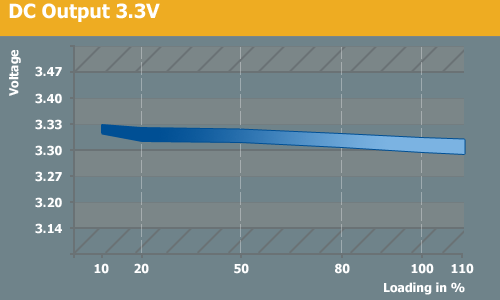
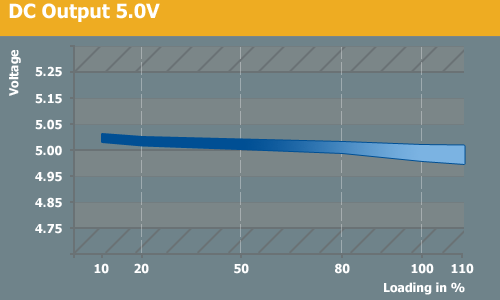
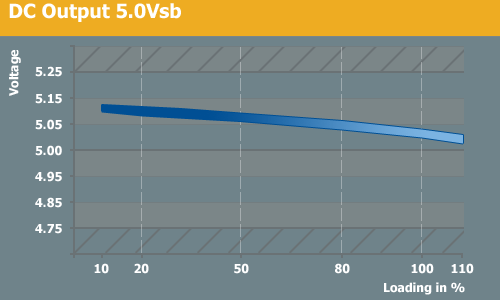
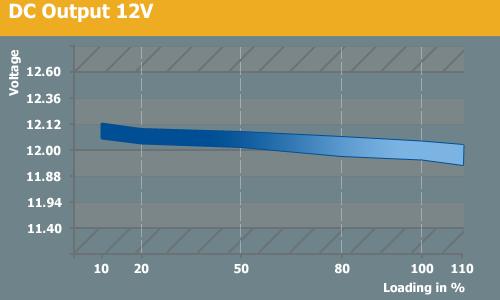
The output stability is very good and none of the rails really fall off. Xigmatek has a good ODM power supply here that uses a slightly older design. On the positive side these designs have been developed and improved so we find a technically mature power supply with nice output stability and good quality.
Efficiency
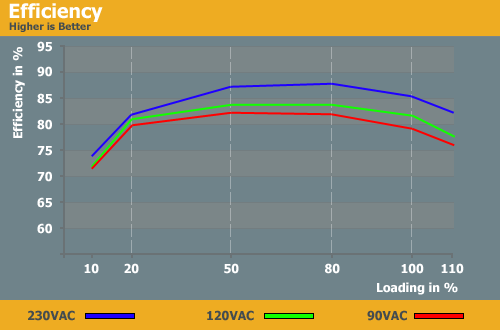
We are including two different graphics of efficiency. The first shows the efficiency at the load percentages and the second shows the efficiency at the different wattage outputs. The second one gives users a better comparison to other power supplies. If you know the amount of power your system requires, you can look up that load in the table below and see what efficiency the power supplies will provide.
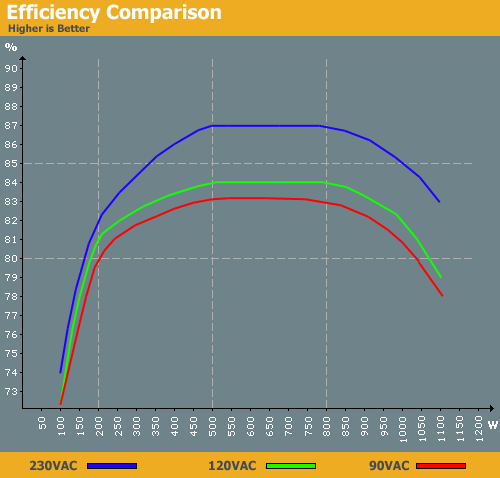
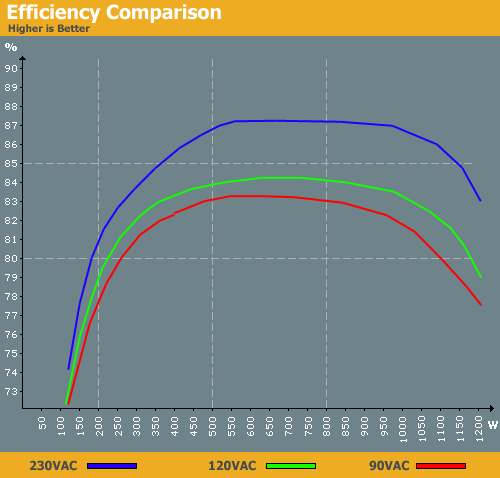
Not long ago a power supply company came to us and urged us to use the 80Plus table to load the power supplies instead of the ATX norm. The 80Plus table only looks at 20%, 50% and 100% of load which is quite narrow minded in our opinion and not really useful for our range of tests at all. An important factor is left out and that it where most system run, most of the time: around 10% of their maximum output in idle mode (at least on larger PSUs). Even though both calculation tables both look similar, we will still stick to the ATX norm which just makes more sense.
The efficiency of these two models is very good and the graphs show that users with a huge power usage will benefit most in energy savings. From 500W upwards, power output on these two units reaches an efficiency of 87% at 230VAC. In the US and other locations that use 115VAC, these units still run with a maximum efficiency of up to 84% over a large range of load. For users that run at less than 500W of load (most of the time), these power supplies won’t make much economic sense since you can buy a unit with a lower output rating and save a lot of money.
Power Factor Correction
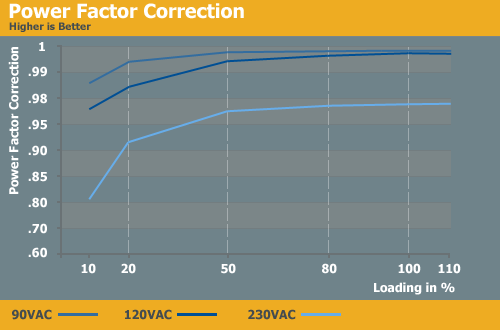
As always the power factor correction is much better with lower input voltage. This unit covers more than .99 (PFC) even with the lower loads. People in Europe need to be happy with an average result of .98 (PFC) tops.
Fan Speed and Acoustics
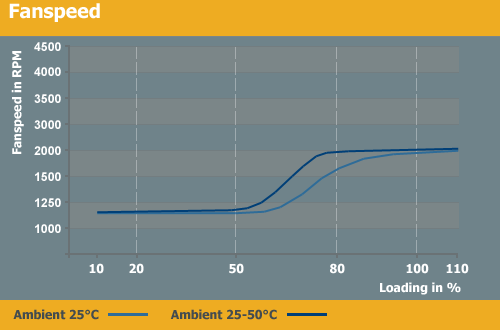
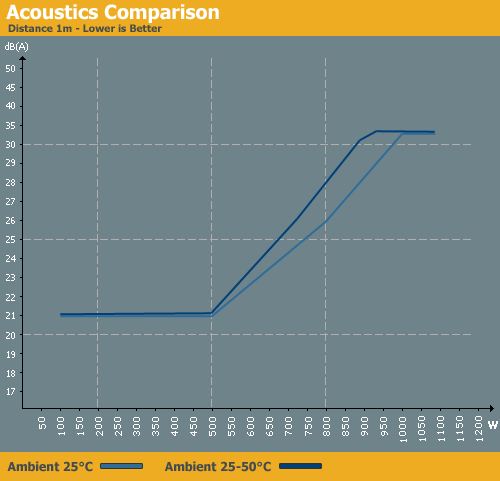
Both of the units are clearly audible while running even at the lowest load, or in fact with no load at all. The fan runs with a minimum of 1200RPM, which should not be necessary as a minimum. The noise levels therefore start at 21dB(A), but listening to the fan it seems much louder than that. With increased loads, the fan quickly starts to spin faster past the 50% load mark, and beyond 650W it's quite loud. The highest result we measured was 33dB(A) with a fan speed of 2000RPM. That's still a reasonable result but again we have to add that the sound coming from the power supply seems much louder than the 33dB(A) we’ve heard before from other units.
Conclusion
Xigmatek is a rather new company on the market, and they have gained fame through their good CPU coolers. The prices have always been fair and people get one of the best price-performance ratios possible. With power supplies, the company has tried to venture into new territories. Like many others, they chose CWT as the manufacturer for their power supplies - given the design has found so many buyers, it's reasonable to assume CWT is doing their job well. Maybe it’s simply a low buying price or generally good performance. Other companies have made claims that the basic CWT design is practically unusable as there are too many flaws inherent in the design. However, there are more and more companies using CWT-based designs, and we have not encountered any difficulties with the latest releases. If there were any flaws previously, they have apparently been corrected.
Xigmatek delivered good performance today with their CWT-manufactured unit, so Xigmatek is already making a good standard in the market place. The build quality is, as usual, very good - what we would expect from such a unit in this higher end field. They also provide a very innovative package design which will definitely prove to be an eye-catcher once these units are on display in a shop. Most importantly, the unit build quality is very good and it withstood our tests without sweating.
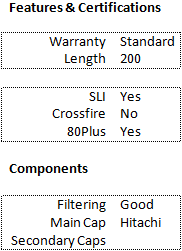 |
There are enough cable harnesses and connectors on this unit to power up massive disk arrays and triple-SLI systems. We think it's strange that companies always seem to provide the same number of SATA and Molex connectors, but the demand for Molex connectors is still high, so we won’t see a drop in the number of Molex connectors in the near future. For modular power supplies, we think it's a good idea to include a few extra harnesses so that end users can choose to have either more SATA connectors or more Molex connectors.
With six PEG connectors, these two power supplies can power up every triple-SLI system available. 1000W is actually the lowest power supplies that NVIDIA will officially certify for triple-SLI, even though it isn't always necessary particularly on high-end models. We personally are running a triple-SLI system with three 8800 Ultra graphics cards, a quad-core Core 2 Extreme, and eight hard drives; this is all running with our special edition PC Power & Cooling Turbo Cool 860.
At the end of the day, performance is what counts, and both of the units were really good. The voltage didn’t drop too much on any rail, regardless of what load we applied. Ripple does seem to be a problem, since there were slightly higher results on both units (similar to other CWT manufactured PSUs), but that’s nothing to worry about since everything is still within specification.
From the efficiency graphs you will see that it really doesn’t make sense to run these power supplies with a wannabe system. You need a serious load applied to the power supply in order to reach a good efficiency rating. We said earlier that a good start would be 500W as a normal load, and that is surely not possible with single or dual graphics cards. These power supplies are made for the most hardcore PC enthusiasts who know how to overclock a quad-core triple-SLI system; otherwise, these units will fall asleep delivering only a few hundred watts of power. At 500W, we measured 87% efficiency with an AC input of 230 volts. US citizens with 120VAC will have the need to be happy with 84%, which is still a very good result. These units have a very long period of good efficiency that starts at 500W and ends at a massive 1000W power consumption, and that's the power delivered to the PC. The wall outlet will have to deliver around 1200W of power draw! For reference, that's similar to the amount of power used by many larger household vacuums!
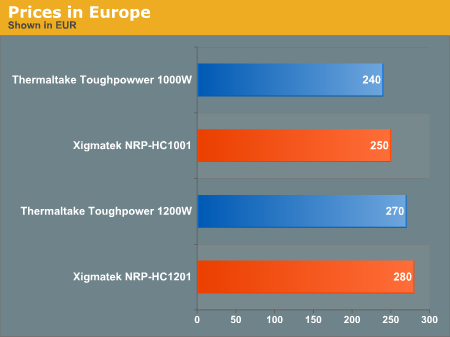
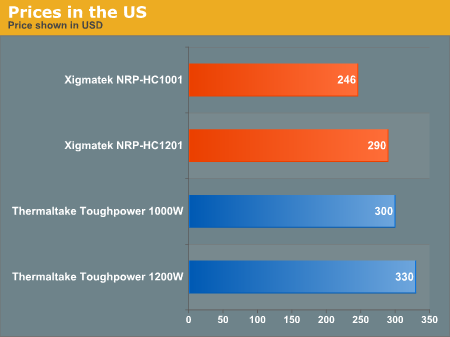
Turning to the price tables, we mentioned in the beginning that Xigmatek offers its coolers at very attractive prices. Can they do the same for their power supplies? We took the liberty to compare the prices to their direct competitor, Thermaltake’s quite similar Toughpower series. On the graphs we see prices in Europe and the U.S and we also see two different price strategies. While Xigmatek has better prices than Thermaltake in the US, they fall behind in Europe where the prices are always at least 10 EUR higher than their competitor. We don’t want to be too melodramatic about 10 EUR, but a higher price is a higher price. It might also be that Xigmatek is just in its early years and doesn’t have equal sales channels compared to a company like Thermaltake. In the US, Newegg has competitive pricing on the Xigmatek units; if you're searching for a high-end power supply, they are certainly worth a look. Besides their performance, users also get an attractive box and a nice looking PSU.













